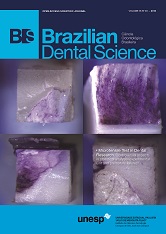Analysis of flexural strength of a self cured acrylic resin used for fabricating provisional restorations with three different types of reinforcements
DOI:
https://doi.org/10.14295/bds.2013.v16i3.905Abstract
Objective: To evaluate the effect of three different types of reinforcements on the flexural strength of a chemically activated acrylic resin.
Materials and Methods: A Universal test machine EMIC 2000 was used at a speed of 5mm/min., to evaluate the flexural strength of 40 test specimens (65mm X 10mm X 3mm) fabricated of chemically activated acrylic resin, distributed into the following four groups: (1) control – without reinforcement; (2) reinforced with 0.7mm stainless steel orthodontic wire; (3) reinforced with Fibrex-lab® glass fiber and; (4) reinforced with Perma-Fiber®glass fiber.
Results: The following flexural strength values were obtained: Group 1 – 80.60 MPa; Group 2 – 95.96 MPa; Group 3 – 105.70 MPa; and Group 4 – 108.70 MPa. The analysis of variance (p < 0.05) showed significant difference among the groups and the Tukey test showed that the control group presented the worst behavior, followed by reinforcement with metal wire, which showed statistically similar results to those of Group 3, with no difference shown between the fiber groups.
Conclusion: Reinforcement with glass fibers present better flexural strength in comparison with the other methods.
Downloads
Downloads
Published
How to Cite
Issue
Section
License
Brazilian Dental Science uses the Creative Commons (CC-BY 4.0) license, thus preserving the integrity of articles in an open access environment. The journal allows the author to retain publishing rights without restrictions.
=================




























